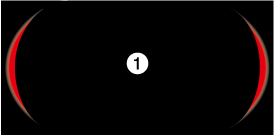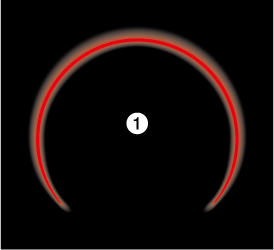

How to Use the Smart Brake Support (SBS)
During the SBS brake control, the brake pedal may move rearward or become stiff. The brakes are operating, but continue to depress the brake pedal.
When the forward detection function operates (Some Models)
The forward detection function operates when all of the following conditions are met.
-
(If an object is a vehicle ahead)
-
The vehicle speed is about 4 km/h (3 mph) or faster.
-
-
(If an object is a bicycle/pedestrian)
-
The vehicle speed is about 10 km/h to 80 km/h (6.3 mph to 49 mph).
-
-
The DSC does not operate.
-
The system determines that there is a possibility of a collision with an object ahead.
When the forward detection function operates, the driver is notified of the danger by the screen display and warning sound. Furthermore, if the possibility of a collision increases, brake control is performed.
Instrument cluster (Type A)

-
“BRAKE!”
Instrument cluster (Type B)

-
“BRAKE!”
Active driving display

-
“BRAKE!”
-
If any of the following conditions is met, the forward detection function may not operate normally.
-
When there is the possibility of a partial contact with a target object.
-
The driver deliberately performs driving operations (accelerator pedal operation, steering wheel operation, selector lever operation, and turn signal lever operation).
-
If any of the following conditions is met, the forward detection function may operate.
-
An animal or object on the road is detected.
-
Passing an approaching vehicle while rounding a curve.
-
Vehicle is passing through a narrow gate or a gate with a low ceiling.
-
There is a metal object, bump, or a protruding object on the road.
-
-
(Vehicles with Driver Monitoring (DM))
If the system determines that the driver is not paying attention to the road, it activates the collision warning earlier than normal.
-
If the forward detection function performs brake control and the vehicle is stopped, the system will continue to hold the brakes for a brief time unless there is an operation performed by the driver.
-
The operation distance and volume of the collision warning can be changed.
Refer to the Settings section in the Mazda Connect Owner's Manual.
The Turn-Across Traffic operation conditions (Some Models)
The Turn-Across Traffic operates when all of the following conditions are met.
-
The vehicle speed is about 4 km/h to 20 km/h (3 mph to 12 mph).
-
The left turn signal light is turned on and the vehicle is turning left.
-
A lane line between your vehicle and the vehicle approaching in the opposite direction is detected.
-
The system determines that there is a possibility of collision with an object ahead.
When the Turn-Across Traffic operates, the driver is notified of the danger by the screen display and warning sound. Furthermore, if the possibility of a collision increases, brake control is performed.
Instrument cluster (Type A)

-
“BRAKE!”
Instrument cluster (Type B)

-
“BRAKE!”
Active driving display

-
“BRAKE!”
-
If any of the following conditions is met, the Turn-Across Traffic may not operate normally.
-
The Forward Sensing Camera (FSC) cannot detect target objects.
Refer to Forward Sensing Camera (FSC) (Search).
-
The front radar sensor cannot detect target objects.
Refer to Radar Sensors (Search).
-
The vehicle approaching in the opposite direction is a two-wheeled vehicle or a bicycle.
-
All of or only a part of a vehicle approaching in the opposite direction is hidden and it cannot be recognized.
-
The speed of the on-coming vehicle is too slow or too fast.
-
Turning at a large intersection with two lanes or more on one side.
-
The accelerator pedal or brake pedal is being operated.
-
The steering wheel is being operated in the straight-ahead position.
-
-
The Turn-Across Traffic may not operate depending on the country where the vehicle is driven.
-
If any of the following conditions is met, the Turn-Across Traffic may operate.
-
The steering wheel is turned towards the on-coming traffic lane with a vehicle approaching in the opposite direction.
-
Turning right after or right before an oncoming vehicle passes.
-
The direction of movement of a vehicle approaching in the opposite direction cannot be predicted due to sudden right/left turning or sudden deceleration.
-
-
The brakes are released by the brake control of the Turn-Across Traffic as soon as the danger of a collision passes.
When Front Crossing is Operating (Some Models)
The Front Crossing operates when all of the following conditions are met.
-
The vehicle is traveling straight at a speed of about 5 km/h to 20 km/h (3 mph to 12 mph).
-
The DSC/TCS is not operating.
-
When an approaching vehicle is traveling straight in a direction perpendicular to your vehicle.
-
The approaching vehicle is traveling at a constant speed within the range of about 20 km/h to 60 km/h (12 mph to 37 mph).
-
The system determines that there is a possibility of a collision with a vehicle approaching from the front.
-
Front Crossing may not operate normally if any of the following conditions is met.
-
If the front side radar sensors cannot detect any target objects, Front Crossing may not operate correctly.
Refer to Radar Sensors (Search).
-
The accelerator pedal or brake pedal is being operated.
-
The steering wheel is being operated.
-
The turn signal lever is being operated.
-
-
If Front Crossing performs brake control and the vehicle is stopped, the vehicle is held stopped until the estimated passing time of the target vehicle has elapsed.
When the intersection accident avoidance assist function operates (Some Models)
The intersection accident avoidance assist function operates when all of the following conditions are met.
-
The vehicle speed is about 8 km/h to 20 km/h (5 mph to 12 mph).
-
The DSC is not operating.
-
The system determines that there is a possibility of a collision with an object ahead.
If the intersection accident avoidance assist function operates, a screen display and warning sound the driver notify the driver of the danger. Furthermore, if the possibility of a collision increases, brake control is performed.
Instrument cluster (Type A)

-
“BRAKE!”
Instrument cluster (Type B)

-
“BRAKE!”
Active driving display

-
“BRAKE!”
-
If the Forward Sensing Camera (FSC) cannot detect objects, the intersection accident avoidance assist function may not operate normally.
Refer to Forward Sensing Camera (FSC) (Search).
-
If the intersection accident avoidance assist function performs brake control and the vehicle is stopped, the system will continue to hold the brakes for a brief time unless there is an operation performed by the driver.
When the rearward detection function operates (Some Models)
The rearward detection function operates when all of the following conditions are met.
-
The vehicle speed is about 2 km/h to 15 km/h (2 mph to 9.3 mph).
-
The system determines that there is a possibility of collision with an object at the rear.
When the rearward detection function operates, the screen display and warning sound notify the driver of the danger. Furthermore, if the possibility of a collision increases, brake control is performed.
Instrument cluster (Type A)

-
“BRAKE!”
Instrument cluster (Type B)

-
“BRAKE!”
Active driving display

-
“BRAKE!”
-
If any of the following conditions is met, the rearward detection function may not operate normally.
-
If any of the following conditions is met, the rearward detection function may operate.
-
There is a hanging curtain.
-
Vehicle is passing through a narrow gate or a gate with a low ceiling.
-
There is a metal object, bump, or a protruding object on the road.
-
-
If the rearward detection function performs brake control and the vehicle is stopped, the system will continue to hold the brakes for a brief time unless there is an operation performed by the driver.
When the Rear Crossing is operating (Some Models)
The Rear Crossing operates when all of the following conditions are met.
-
The vehicle speed is about 15 km/h (9.3 mph) or slower.
-
The system determines that there is a possibility of a collision with a vehicle approaching from a rear side.
When the Rear Crossing operates, the screen display and warning sound notify the driver is notified of the danger. Furthermore, if the possibility of a collision increases, brake control is performed.
Instrument cluster (Type A)

-
“BRAKE!”
Instrument cluster (Type B)

-
“BRAKE!”
Active driving display

-
“BRAKE!”
-
If any of the following conditions is met, the Rear Crossing may not operate normally.
-
The rear side radar sensors cannot detect an object.
Refer to Radar Sensors (Search).
-
A vehicle is approaching directly from the rear of your vehicle.
-
A vehicle is approaching at an angle from the rear of your vehicle.
-
A vehicle is approaching from a direction at an acute angle.
-
-
If any of the following conditions is met, the Rear Crossing may operate.
-
There is a hanging curtain.
-
Vehicle is passing through a narrow gate or a gate with a low ceiling.
-
-
If the Rear Crossing performs brake control and the vehicle is stopped, the system will continue to hold the brakes for a brief time unless there is an operation performed by the driver.
Turning off the SBS
The SBS can be turned off using the Mazda Connect.
Refer to the Settings section in the Mazda Connect Owner's Manual.
The following functions can also be turned off using the i-ACTIVSENSE OFF switch.
-
Rearward detection function
-
Rear Crossing
Refer to How to Use the i-ACTIVSENSE OFF switch (Search).
When the SBS is turned off, the SBS OFF indicator  turns on.
turns on.


